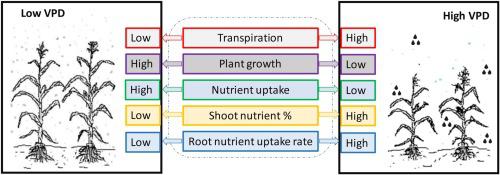当前位置:
X-MOL 学术
›
Environ. Exp. Bot.
›
论文详情
Our official English website, www.x-mol.net, welcomes your
feedback! (Note: you will need to create a separate account there.)
Response of maize (Zea mays L.) towards vapor pressure deficit
Environmental and Experimental Botany ( IF 4.5 ) Pub Date : 2021-01-01 , DOI: 10.1016/j.envexpbot.2020.104293 Ram Kumar Shrestha , Ping Lei , Dan Shi , Mohammad Hanif Hashimi , Sheng Wang , Deti Xie , Jiupai Ni , Chengsheng Ni
Environmental and Experimental Botany ( IF 4.5 ) Pub Date : 2021-01-01 , DOI: 10.1016/j.envexpbot.2020.104293 Ram Kumar Shrestha , Ping Lei , Dan Shi , Mohammad Hanif Hashimi , Sheng Wang , Deti Xie , Jiupai Ni , Chengsheng Ni

|
Abstract The changing atmospheric wetness and dryness in the background of global warming is an important issue for maize cultivation. The objective of this study was to evaluate the physiological response of maize towards vapor pressure deficits (VPDs). To understand the behaviors and the morphology of the stomata that are correlated with the plant biomass and nutrient acquisition, we conducted a pot experiment of maize planting under two levels of VPDs (low 1.1 ± 0.5 kPa; high 2.6 ± 0.7 kPa). Plants exposed to a high VPD (HVPD) condition displayed a higher transpiration rate throughout the growth periods. Stomatal conductance and the intercellular carbon dioxide (CO2) concentration were also higher for the plants at HVPD at later growing phases. At early growth stages, stomata on the adaxial surface of the plants exposed to the HVPD environment was lower in density but they were higher in length and width at the abaxial surface than those exposed to the low VPD (LVPD) condition. HVPD increased considerably the stomatal number 50 days after sowing (d). The higher transpiration of the plants in the HVPD condition appeared to be negatively associated with the biomass and the content of the majority of nutrients. However, plants at the HVPD condition showed a significantly higher root-specific capacity for nutrient uptake and delivered a higher proportion of the absorbed nutrients towards the shoot. Therefore, stomata and nutrient uptake responses to VPD are the important traits to be considered while improving the maize for dry weather regions.
中文翻译:

玉米 (Zea mays L.) 对蒸气压不足的响应
摘要 全球变暖背景下大气干湿变化是玉米种植面临的重要问题。本研究的目的是评估玉米对蒸气压不足 (VPD) 的生理反应。为了了解与植物生物量和养分获取相关的气孔行为和形态,我们在两个 VPD 水平(低 1.1 ± 0.5 kPa;高 2.6 ± 0.7 kPa)下进行了玉米种植盆栽试验。暴露于高 VPD (HVPD) 条件的植物在整个生长期显示出更高的蒸腾速率。在 HVPD 的后期生长阶段,植物的气孔导度和细胞间二氧化碳 (CO2) 浓度也更高。在早期成长阶段,暴露于 HVPD 环境的植物近轴表面的气孔密度较低,但它们在背面的长度和宽度高于暴露于低 VPD (LVPD) 条件的植物。播种后 50 天,HVPD 显着增加了气孔数 (d)。HVPD 条件下植物的较高蒸腾作用似乎与生物量和大部分营养物质的含量呈负相关。然而,处于 HVPD 条件下的植物表现出显着更高的根系特定的养分吸收能力,并向地上部输送更高比例的吸收养分。因此,气孔和养分吸收对 VPD 的反应是在干旱天气地区改良玉米时要考虑的重要性状。
更新日期:2021-01-01
中文翻译:

玉米 (Zea mays L.) 对蒸气压不足的响应
摘要 全球变暖背景下大气干湿变化是玉米种植面临的重要问题。本研究的目的是评估玉米对蒸气压不足 (VPD) 的生理反应。为了了解与植物生物量和养分获取相关的气孔行为和形态,我们在两个 VPD 水平(低 1.1 ± 0.5 kPa;高 2.6 ± 0.7 kPa)下进行了玉米种植盆栽试验。暴露于高 VPD (HVPD) 条件的植物在整个生长期显示出更高的蒸腾速率。在 HVPD 的后期生长阶段,植物的气孔导度和细胞间二氧化碳 (CO2) 浓度也更高。在早期成长阶段,暴露于 HVPD 环境的植物近轴表面的气孔密度较低,但它们在背面的长度和宽度高于暴露于低 VPD (LVPD) 条件的植物。播种后 50 天,HVPD 显着增加了气孔数 (d)。HVPD 条件下植物的较高蒸腾作用似乎与生物量和大部分营养物质的含量呈负相关。然而,处于 HVPD 条件下的植物表现出显着更高的根系特定的养分吸收能力,并向地上部输送更高比例的吸收养分。因此,气孔和养分吸收对 VPD 的反应是在干旱天气地区改良玉米时要考虑的重要性状。











































 京公网安备 11010802027423号
京公网安备 11010802027423号